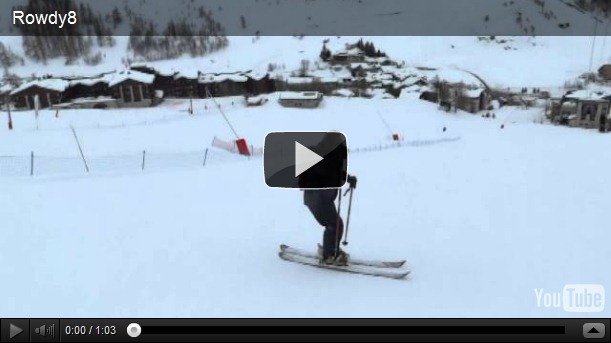Returning from a short break from skiing the most noticeable thing about Rowdy’s skiing was that it had as always returned to its default setting. The amazing process of Rowdy adapting and succeeding on every training session – then reverting back to scratch later on – continues. It’s becoming clear that the problem is not anything specific in skiing – it’s a problem of awareness. The unconscious processes that are already deeply ingrained always come back to dominate and anything new is discarded. Even the understanding is re-routed and confused by those unconscious acts. Only persistence in the relevant areas will change this.
Perpendicular – “turn exit” dynamics
We tried working on chi-hips at first but it made no appreciable difference. All of Rowdy’s main issues returned. I decided not to persist in that direction for the moment and to work on the turn exit dynamics to try to work directly on eliminating the unwanted stemming issues. I explained once again that when using dynamics you need to end the turn in the perpendicular with the skis flat. This means that the outside ski needs to lift you up and out of the turn at the end – beyond vertical and into the perpendicular across the hill. At this point you can change leg for starting the next turn. There will be no pressure from the skis at this point and reduced pressure from gravity because you are already falling (past vertical) – so it’s easy to change support leg. However I used the motorbike analogy to describe the entire arc carried out on one ski – falling down and into the turn and then back up and out – but with everything relating to a slope and perpendicular instead of the flat and vertical. In a nutshell, Rowdy’s main issue is probably that he relates everything to vertical – and that might even be linked to his motorbike experience. The success of this approach wasn’t great.
Turn Transitions
Instead of looking at the turn as two separate arcs I shifted focus onto the turn transition – which in mathematics would be called an inflexion curve. My aim was to drill Rowdy specifically in dealing with the turn transition while relating to perpendicular. The exercises here in the video show a positioning of the body and support from the pole that permits the body to be moved downhill until eventually the supporting lower ski starts to slip. At this point the support leg has to change. Rowdy can be seen at times holding on to the lower ski and not changing early enough. Other times he involuntarily twists and stems the left ski even when it is held in the air – crossing the lower support ski. This is what is also happening when Rowdy skis (though without the body moving downhill) – but here there is a chance to separate it all out and to correct the timing and accuracy of the change of support leg – and the direction of motion of the centre of mass. The key is to avoid twisting anything and feel how the centre of mass – by moving it appropriately, makes the turn happen. The pole support helps through the vertical to perpendicular phase while standing statically on the lower ski and at just around perpendicular the skis will start to slide and the leg change occurs. Later on we were able to reintroduce the chi-hips so that Rowdy could improve his angulation and so manage this relatively static exercise more easily and effectively. We finished by linking rhythmic turns without turning too much across the hill, so that Rowdy could feel the flow that comes from getting the turn transition right and by working around the perpendicular instead of the vertical. Skiing is a perpendicular world not a vertical one. There are many other ways to make turn transitions – with leg retraction for example, with or without angulation, on either or both legs, with or without dynamics – on the uphill or downhill edges – stepping, stemming etc. etc. the list goes on. The important thing is to be able to chose the transition that is needed to direct the body and skis where they need to go. We worked only by using the most basic but important pressure and timing cycle – the down/up cycle. The one thing common to all transitions is the need to sense perpendicularity – so this is what we focused on.
Unusual visitor
Spotted this unusual bird at 2500m altitude. It’s not a snow bunting with white flashes like we normally see. I don’t know what it is.

